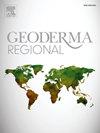Mapping soil parent materials in a previously glaciated landscape: Potential for a machine learning approach for detailed nationwide mapping
IF 3.1
2区 农林科学
Q2 SOIL SCIENCE
引用次数: 0
Abstract
Reliable information on soil-forming parent materials is crucial for informed decision-making in infrastructure planning, land-use management, environmental assessments, and geohazard mitigation. In the northern landscapes previously affected by glacial processes, these parent materials are predominantly Quaternary deposits. This study explored the potential of machine learning to expedite soil parent material mapping in Sweden. Two Extreme Gradient Boosting models were trained, one using terrain and hydrological indices derived from Light Detection and Ranging data, and the other incorporating additional ancillary map data. Both models were trained on 29,588 soil observations and evaluated against a separate hold-out set of 3500 observations. As a baseline, the existing most detailed maps achieved a Matthews Correlation Coefficient of 0.36. The Extreme Gradient Boosting models achieved higher MCC values of 0.45 and 0.56, respectively. To understand spatial variations in model performance, the second model was evaluated across 28 physiographic regions in Sweden. The results revealed that model performance varied across regions and deposit types, with till and peat exhibiting better performance than sorted sediments. These findings underscore the need for region-specific analyses to optimize the application of machine learning in digital soil mapping.
测绘以前冰川景观中的土壤母质:用于详细全国测绘的机器学习方法的潜力
关于土壤形成母质的可靠信息对于基础设施规划、土地使用管理、环境评估和减轻地质灾害方面的知情决策至关重要。在先前受冰川作用影响的北部景观中,这些母质主要是第四纪沉积物。这项研究探索了机器学习在瑞典加速土壤母质测绘的潜力。训练了两个极端梯度增强模型,其中一个模型使用了来自光探测和测距数据的地形和水文指数,另一个模型使用了额外的辅助地图数据。这两个模型都在29,588个土壤观测数据上进行了训练,并对单独的3500个观测数据进行了评估。作为基线,现有最详细的地图的马修斯相关系数为0.36。极端梯度增强模型的MCC值更高,分别为0.45和0.56。为了了解模型性能的空间差异,第二种模型在瑞典的28个地理区域进行了评估。结果表明,模型的性能因地区和沉积物类型而异,泥炭和泥炭表现出比分选沉积物更好的性能。这些发现强调需要进行特定区域的分析,以优化机器学习在数字土壤制图中的应用。
本文章由计算机程序翻译,如有差异,请以英文原文为准。
求助全文
约1分钟内获得全文
求助全文
来源期刊

Geoderma Regional
Agricultural and Biological Sciences-Soil Science
CiteScore
6.10
自引率
7.30%
发文量
122
审稿时长
76 days
期刊介绍:
Global issues require studies and solutions on national and regional levels. Geoderma Regional focuses on studies that increase understanding and advance our scientific knowledge of soils in all regions of the world. The journal embraces every aspect of soil science and welcomes reviews of regional progress.
 求助内容:
求助内容: 应助结果提醒方式:
应助结果提醒方式:


